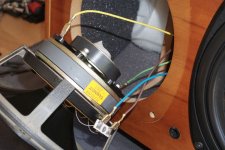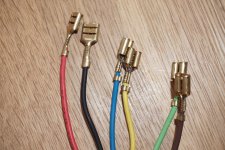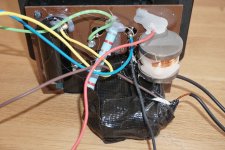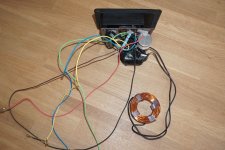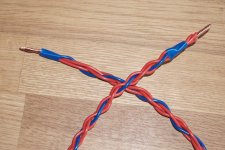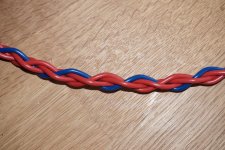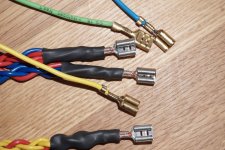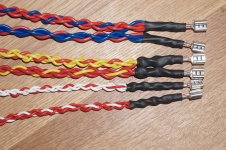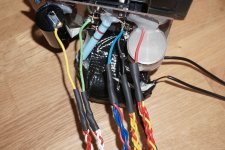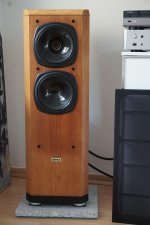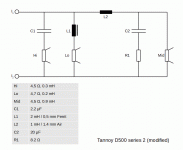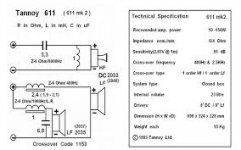When fixing one of the bass speaker surrounds, as described here, I also had a closer look at the crossovers and the internal wiring - and I was not too happy with what I found. (Shifting from 'repair' to 'modification', I considered it's better to start a new thread.)
A bit of history: I had bought those speakers around 2002 / 2003 from a small dealer who claimed to have modified the original crossovers and had used those speakers for demo in his shop for a while. The price was reasonable, sound was great.
Now, more than 15 years later, they still sounded great. This is true for use with a pair of Quad II (early 1960s), which I used until January this year, and even more now with my newly restored Quad 303 in combination with a Rotel 1570 preamp.
But looking at the internal wiring I could not resist to think: there must be more in store, soundwise!
What I found were 'van den Hul M.C. CS18' halogen free cable. van den Hul website states that these are 0.56 sqmm 7-strand silver coated copper, and they recommend these cables for tweeter use. These cables were used for all internal connections between crossover and speakers.
Looking closer, the silver coating seemed to be corroded where the cables meet the cable shoes.
Next, the crossovers. Just look for yourselves! In my early years, as an apprentice, my boss would have thrown me out of the lab if I had delivered something like this, even as a prototype.
What to do next? I can see a Mundorf capacitor, and an air core inductor, which add to my confidence. I decided to leave the crossovers unchanged for the moment and focus on the wiring. 0.56 sqmm for bass and mid range - I doubt that this is appropriate.
A bit of history: I had bought those speakers around 2002 / 2003 from a small dealer who claimed to have modified the original crossovers and had used those speakers for demo in his shop for a while. The price was reasonable, sound was great.
Now, more than 15 years later, they still sounded great. This is true for use with a pair of Quad II (early 1960s), which I used until January this year, and even more now with my newly restored Quad 303 in combination with a Rotel 1570 preamp.
But looking at the internal wiring I could not resist to think: there must be more in store, soundwise!
What I found were 'van den Hul M.C. CS18' halogen free cable. van den Hul website states that these are 0.56 sqmm 7-strand silver coated copper, and they recommend these cables for tweeter use. These cables were used for all internal connections between crossover and speakers.
Looking closer, the silver coating seemed to be corroded where the cables meet the cable shoes.
Next, the crossovers. Just look for yourselves! In my early years, as an apprentice, my boss would have thrown me out of the lab if I had delivered something like this, even as a prototype.
What to do next? I can see a Mundorf capacitor, and an air core inductor, which add to my confidence. I decided to leave the crossovers unchanged for the moment and focus on the wiring. 0.56 sqmm for bass and mid range - I doubt that this is appropriate.
Attachments
So, what to do? Between my Quad 303 and the Tannoys, the signal is delivered via Kimber Kable 8PR - which are great! So why not have a nice little exercise in handicraft and produce some pseudo-Kimbers for the internal wiring? I have enough 1 sqmm and 0.5 sqmm pure copper in my shelf, so why not?
A first exercise in the evening - see pics. It took a bit of time before the result became a bit more even and tight. Practice matters!
I decided to go for a simple braiding of 4 * 0,5 sqmm for treble, and 4 * 1 sqmm for mid range and bass, respectively.
A first exercise in the evening - see pics. It took a bit of time before the result became a bit more even and tight. Practice matters!
I decided to go for a simple braiding of 4 * 0,5 sqmm for treble, and 4 * 1 sqmm for mid range and bass, respectively.
Attachments
Last edited:
Next morning: now really go for it! It took a while before enough length was produce, and I must admit: my fingers hurt just a little bit afterwards!
I decided to leave some stubs of the original van den Hul at the crossovers for now, which is certainly not ideal. But I still have the idea in mind to make the crossovers themselves a 'bit nicer', even if they are hidden inside housing all the time.
I decided to leave some stubs of the original van den Hul at the crossovers for now, which is certainly not ideal. But I still have the idea in mind to make the crossovers themselves a 'bit nicer', even if they are hidden inside housing all the time.
Attachments
A first listening experience.
I'm well aware of the fact that this might start some discussion about whether it makes sense to braid audio cables. My former experience when changing from good 'standard' speaker cables to Kimber gave me confidence that this might pay out.
Now for listening: I chose several tracks I really know well (jazz, singer-songwriter, blues, classics) - and my equipment produced a sound like some overtight girdle had been taken from it.
Double bass was more present on the sound stage - effects on bass was what I expected most. A church organ was much more 'real' - but I still think that when it comes to very low tones, no speaker in the world can reproduce a church organ really well.
Voices were what struck me the most: much more stability and locatability. Very relaxed and powerful at the same time. Sensing choirs or symphonic orchestras as individual musicians became much easier.
Even treble got better. Jazz piano in high tones is clearer now, has more 'body'. And the sibilants of vocalists, which often disturbed me especially in technically not so good recordings, lost at least a bit of their sharpness, but not all of it.
Now I think about the reasons for those audible changes:
I'm well aware of the fact that this might start some discussion about whether it makes sense to braid audio cables. My former experience when changing from good 'standard' speaker cables to Kimber gave me confidence that this might pay out.
Now for listening: I chose several tracks I really know well (jazz, singer-songwriter, blues, classics) - and my equipment produced a sound like some overtight girdle had been taken from it.
Double bass was more present on the sound stage - effects on bass was what I expected most. A church organ was much more 'real' - but I still think that when it comes to very low tones, no speaker in the world can reproduce a church organ really well.
Voices were what struck me the most: much more stability and locatability. Very relaxed and powerful at the same time. Sensing choirs or symphonic orchestras as individual musicians became much easier.
Even treble got better. Jazz piano in high tones is clearer now, has more 'body'. And the sibilants of vocalists, which often disturbed me especially in technically not so good recordings, lost at least a bit of their sharpness, but not all of it.
Now I think about the reasons for those audible changes:
- Larger cable cross section? Yes, sure!
- Pure copper instead of silver coated copper? Maybe, especially for treble.
- The braided geometry, my 'pseudo-Kimber'? I'm sure: it plays a least some role while enhancing the sound of my Tannoys!
It's always nice to see the subject in all its glory! Tannoy Definition D500 - Hi-Fi Database - Floorstanding Speakers
There's information about the original D500 crossover in this thread: Tannoy D500 crossover
There's information about the original D500 crossover in this thread: Tannoy D500 crossover
By the way: I was not successful so far in finding detailed information about the original D500 crossovers. If available, could somebody post schematics and / or a photo?
The subject in all its glory? Ok, here you are!It's always nice to see the subject in all its glory!
Attachments
Ok, analyzed that modified crossover this morning. I'm a bit puzzled about the result - see pic.
Obvious target for possible enhancement would certainly be that L1, which could be replaced by an air core model.
But I'm having some problems understanding the crossover as a whole. Bass and tweeter are easy, imho: simply 6 dB lowpass and 6 dB highpass, right?
I would understand L2 as another lowpass filter for the midrange speaker. But C2 / R1 do not correspond with any basic crossover schematics I came across so far.
Another mystery (at least to me): while that 2 mH L1 results in about 400 Hz crossover frequency, like reported for the D500, the 2.2 uF in the highpass section would result in over 12 kHz crossover frequency for the tweeter. 😕
Can anybody assist me in interpreting this schematics?
Obvious target for possible enhancement would certainly be that L1, which could be replaced by an air core model.
But I'm having some problems understanding the crossover as a whole. Bass and tweeter are easy, imho: simply 6 dB lowpass and 6 dB highpass, right?
I would understand L2 as another lowpass filter for the midrange speaker. But C2 / R1 do not correspond with any basic crossover schematics I came across so far.
Another mystery (at least to me): while that 2 mH L1 results in about 400 Hz crossover frequency, like reported for the D500, the 2.2 uF in the highpass section would result in over 12 kHz crossover frequency for the tweeter. 😕
Can anybody assist me in interpreting this schematics?
Attachments
L2 and C2 form a bandpass filter for the midrange driver.
Details here: Band-pass filter 6dB per octave
Details here: Band-pass filter 6dB per octave
Is 4.5ohm the measured DC resistance of your drivers, duplex?
If so, the nominal impedance is probably around 6ohm.
That may be a better value to use in your crossover frequency calculations.
If so, the nominal impedance is probably around 6ohm.
That may be a better value to use in your crossover frequency calculations.
The slope of the high pass filter is very shallow (only 6db/octave), so the tweeter will reproduce frequencies below the calculated crossover frequency of 12kHz.Another mystery (at least to me): the 2.2 uF in the highpass section would result in over 12 kHz crossover frequency for the tweeter. 😕
In fact, the tweeter will make a substantial contribution down towards 6kHz.
Scrub that, it's wrong - L2 and C2 are not in series with the midrange driver! Sorry! 😱L2 and C2 form a bandpass filter for the midrange driver.
Instead, L2 forms a low pass filter and C2 and R1 form an impedance correction network.
Last edited:
Our posts crossed pcb! I haven't factored in the component values so will assume you are correct. I have obviously proved myself unreliable regarding the midrange filter! 🙂
Sorry about the second post... the slopes proposed by the crossover are considering the acoustic output of the drivers and you typically wouldn't know those contributions without more info. Could be gotten by direct measurement.
Yes, it is.Is 4.5ohm the measured DC resistance of your drivers, duplex?
Nominal impedance as stated for the D500 is 6 Ohm.
Ok, it's shallow, but 12 - 14 kHz is really high, isn't it? Original crossover frequency for the tweeter is reported to be around 1700 Hz. This dicrepancy is why I'm interested in the original Tannoy layout.The slope of the high pass filter is very shallow (only 6db/octave), so the tweeter will reproduce frequencies below the calculated crossover frequency of 12kHz.
In fact, the tweeter will make a substantial contribution down towards 6kHz.
So far I've learned that those simple calculations are no more than theory, and do not have so much in common with real values. But closing the gap between 12 kHz and 1700 Hz is hard, imo.
I see information on forums that the crossover frequencies are 400Hz and 1700Hz.
That would not appear to be compatible with your crossover schematic, as you suspect!
That would not appear to be compatible with your crossover schematic, as you suspect!
- Home
- Loudspeakers
- Multi-Way
- Tuning my Tannoys (Definition Series D500)
